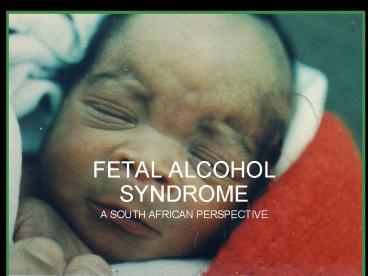FETAL ALCOHOL SYNDROME - PowerPoint PPT Presentation
1 / 37
Title:
FETAL ALCOHOL SYNDROME
Description:
One - two drinks per day ( 30ml AA) Five - six drinks per occasion per week ( 90ml AA) ... 8/1000 Native American Indians. 1.2/1000 France. Developed world. 0.97/1000 ... – PowerPoint PPT presentation
Number of Views:288
Avg rating:3.0/5.0
Title: FETAL ALCOHOL SYNDROME
1
- FETAL ALCOHOL SYNDROME
- A SOUTH AFRICAN PERSPECTIVE
2
Fetal alcohol syndrome is the most common
preventable cause of mental retardationin the
world
(Sampson PD et al. Teratology (1997) 56317-326)
3
RISK FACTORS
- Volume of alcohol consumed
- Duration and timing of drinking during pregnancy
- Additional substance abuse
- Age
- Parity
- Genetic factors
- Health status of the mother
- Poverty
- Low maternal education
- Partner, other family members and friends who
also drink
4
(No Transcript)
5
Physical characteristics
6
Clinical characteristics of FAS
- Growth retardation
- Characteristic facies
- Neurological deficits
- Other
- Maternal alcohol abuse
7
(No Transcript)
8
Characteristic facies
- Hypoplasia of the middle third of the face
- Short upturned nose
- Flattened nasal bridge
- Epicanthic folds
- Short palbebral fissues
- Long, smooth upper lip
- Thin vermilion border
- Micrognathia
- Other minor facial features
9
Growth retardation
- Prenatal postnatal
- Screening criteria
- On/below 10th centile height/weight
- On/below 10th centile for head circumference
10
Neurolological sequelae of FAS
- Microcephaly
- Structural brain anomalies
- Behavioural problems
- Hyperactivity
- Poor concentration span
- Inappropriate sexual behaviour
- ADHD-like symptoms
- Problems with the law
- Average IQ 65
11
Neurological sequelae of FAS
- Deficient in aspects of
- Number processing
- Visual-spatial reasoning
- Visual memory
- Verbal learning
- Language
- Motor (fine) functioning
12
SECONDARY DISABILITIES
Definition Disabilities that are not present at
birth, and could be minimised through better
understanding and intervention
13
SECONDARY DISABILITIES
- Mental health problems
- Disrupted school experiences
- Trouble with the law
- Confinement
- Inappropriate sexual behaviour
- Alcohol and other drug problems
14
PROTECTIVE FACTORS
- Stable and nurturing home
- Not having frequent changes of household
- Not being a victim of violence
- Receiving developmental intervention
- Diagnosis before 6 years
15
Heavy drinking in pregnancy
- One - two drinks per day (gt30ml AA)
- Five - six drinks per occasion per week (gt90ml AA)
16
Alcohol metabolism
Blood/alcohol concentration (mg)
Time (hours)
17
Absolute alcohol calculations
- Wine - 10 (150ml 1 drink)
- Beer - 5 (300ml 1 drink)
- Spirits - 30 to 40 (25 - 30ml 1 drink)
15ml AA 1 drink (USA) 10ml AA 1 drink (UK
Europe)
18
INTERNATIONAL FAS RATES
- USA
- 0.3/1000 to 2.2/1000
- 8/1000 Native American Indians
- 1.2/1000 France
- Developed world
- 0.97/1000
19
FAS STUDIES - SOUTH AFRICA
- Western Cape
- Wellington
- Gauteng
- Westbury, Soweto, Diepsloot, Lenasia South
- Northern Cape
- De Aar, Upington
20
RESULTS GAUTENG
FAS Prevalence
Westbury 37/1000 Lenasia South 12/1000
Soweto 19/1000 Diepsloot 0/1000
21
Wellington Epidemiology results
- 1997- 1988 children screened
- 46 FAS
- 7 deferred
- Prevalence 46,4/1000
- 2002- 818 children screened
- - 32 FAS
- - 76 not fully appraised but screened positive
22
UPINGTON Epidemiology results
- Children screened 1358
- Screen positive 758
- FAS and deferred 104
- Not FAS 584
- Estimated FAS prevalence - 77/1000
23
De Aar Epidemiology results
- Children screened 534
- Screen positive 291
- FAS 55
- Deferred 10
- Not FAS 2
- FAS prevalence - 103/1000
24
(No Transcript)
25
(No Transcript)
26
(No Transcript)
27
(No Transcript)
28
Weight for age Z-scores of first grade children
examined in Wellington
Z Scores
Children in Sub-A Class (5-7 years of age)
29
Weight for height Z-scores of first-gradechildren
examined in Wellington
Z Scores
Children in Sub-A Class (5-7 years of age)
30
Height for age Z-scores of first gradechildren
examined in Wellington
Z Scores
Children in Sub-A Class (5-7 years of age)
31
Prevention Projects- 3 year programme
- AIM to reduce the incidence of FAS in the
communities - De Aar
- Clinical examination and neurological assessement
of 9 month old babies - Maternal interview
- Intervention and prevention projects through
education of the communities and awareness - Teacher training to recognise and manage children
with ARBD (FAS) and ARND (FAE)
32
Prevention projects
- Planned in Upington, Kimberley, Gauteng
- Wellington has ongoing intervention
- Nutritional study planned for Upington
- Ongoing research at FARR, WITS, UCT and MRC
including alcohol metabolism, related nutritional
effects, genetic factors and susceptibility of
fetuses to alcohol
33
Education The key to combating FAS
34
LONG TERM GOAL
- To decrease drinking in pregnant women
- To decrease the incidence of FAS in our
communities - To educate the communities regarding the primary
and secondary disabilities associated with
drinking in pregnancy
35
Acknowledgements
- Pat Craig initiated the project with Professor
Denis Viljoen and co-ordinated the education and
training of community workers - Leigh-Anne Fourie-conducting evaluation and
assessment of children - Tina-Marie Wessels Genetic counselling manager
36
- This talk was prepared in fond memory of our
friend and colleague who was dedicated to the
ongoing program for FAS in South Africa - STEFANIE SCHON
37
For further information on FAS and FAS clinics
- NHLS WITS School of Pathology Human Genetics
Division - Tina-Marie Wessels Genetic counselling manager
011 489 9243































